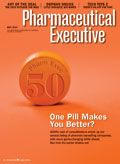Pharma's Big Tradeoff
Pharmaceutical Executive
Under the new healthcare regime, pharma will ante up fees and rebates in return for expanded sales and safeguards.
There is much for pharmaceutical companies to applaud in the new law overhauling the nation's healthcare system. For instance, the goal of providing healthcare benefits to some 32 million uninsured through state-based exchanges and Medicaid greatly expands the market for prescription drugs. Although most states already reimburse, to some extent, for medicines, many of the state Medicaid programs are fairly skimpy. They will now be made more comprehensive.

Jill Wechsler
In addition, insurance market reform—with curbs on denials for pre-existing conditions, as well as on annual and lifetime limits—promises to extend pharmacy benefits to patients with serious or chronic health conditions. Moreover, the scheme to eliminate the contentious "donut hole" in the Medicare drug benefit will help seniors afford high-cost prescriptions.
In return, manufacturers will have to pay fees, rebates, and discounts totaling some $105 billion over ten years, according to Avalere Health. That tally is much higher than the $80 billion the Pharmaceutical Research and Manufacturers of America (PhRMA) had negotiated with Senate Finance Committee chairman Max Baucus (D-MT) and the White House. Still, marketers consider it a reasonable tradeoff, as the new law creates an attractive pathway for developing and marketing biosimilars, sets limits on the use of cost-effectiveness research, and also omits several hot-button items that industry strongly opposed (See "What's Missing in the Bill.")

What's Missing from the Bill
Filling the Hole
Considerable gains will come in the form of greater drug utilization by seniors. Annual wellness visits will produce personal plans recommending immunizations and prescriptions, and annual outreach to low-income beneficiaries will encourage appropriate drug use, plus improved compliance and appeals systems that can facilitate access to needed therapies. The healthcare bill also codifies mandatory Part D coverage of medicines in six protected drug classes, while leaving the door open to future modification.
The biggest change is to close the much-vilified donut hole that now requires seniors to pay the full cost of drugs after spending reaches $2,830 a year. Immediate relief comes from a government rebate of $250 to beneficiaries who fall in the donut hole this year. Beginning in January 2011, manufacturers will cover 50 percent of the negotiated price of brand medicines filled by seniors in the gap. Beneficiaries will pay the reduced price at the pharmacy, and manufacturers will reimburse the difference.
Beginning in 2013, Medicare will begin a campaign to close the donut hole even further by 2020 by phasing in payment for 25 percent of drug expenditures. For generic drugs, Medicare will ramp up coverage of "gap" products, increasing until plans pay 75 percent of the cost in 2020. At that point, policymakers consider the donut hole essentially closed because the remaining 25 percent patient share will be in line with copays on drugs prior to hitting the coverage gap.
Paying Plenty
While these donut hole discounts will cost manufacturers some $32 billion over ten years, the change eliminates a major source of confusion for elderly patients and is slated to boost compliance by the growing number of seniors who stop taking drugs or switch to generics when they hit the gap. Beneficiaries also will move through the donut hole more quickly to catastrophic coverage where Medicare pays 95 percent of drug costs.
To offset the government's $38 billion share for closing the donut hole, manufacturers will pay another $28 billion in new fees over ten years, starting with $2.5 billion in 2011. Total collections will rise to $4 billion in 2017, then drop to $2.8 billion in 2019 and subsequent years. The Treasury Department will apportion yearly fees based on a company's relative share of branded drug sales to Medicare, Medicaid, the Veterans Administration, and Department of Defense healthcare programs. Manufacturers with government sales less than $5 million will get a pass; those with over $400 million a year pay a full share.
Pharma companies also will ante up $38 billion more in Medicaid rebates. The rebate jumps from 15 percent to 23.1 percent of average manufacturer price for brands, and from 11 percent to 13 percent for generics, retroactive to the beginning of 2010. That essentially raises the "best price" on many drugs, opening the door to deeper discounts on drugs sold to private plans. Rebates also extend to new formulations of oral solid dosage forms, and can now be collected by Medicaid managed care organizations—a change that might encourage community health plans to press for additional discounts.
Encouraging Innovation
Manufacturers aren't complaining too loudly about the new costs because they gain an attractive pathway for the Food and Drug Administration to authorize follow-on biologics (FOBs). Despite strong opposition from powerful legislators and the White House, innovator firms won a record 12-year data-exclusivity period for reference biotech products, with a possible six-month extension for sponsors that conduct pediatric studies. The Congressional Budget Office says the program will save the government—and cost manufacturers—$7 billion over ten years. But generics makers counter that the gains could have been over $50 billion, and that this is just a big giveaway to Big Pharma.
All manufacturers could benefit from clarity for developing and marketing "biosimilars" and "biobetters." FDA now has the task of issuing guidance on what assays and clinical studies will be needed to document FOB safety, purity, and potency, as well as what criteria could support product interchangeability—a critical issue for marketing and reimbursement. Sponsors will pay FDA user fees; there's a process for innovators to challenge patent infringement; and Medicare Part B will pay for biosimilars at average sales price plus 6 percent—an amount considered high enough to encourage physician prescribing of less costly FOBs.
Another plus for industry is language limiting use of comparative effectiveness research (CER) sponsored by the new non-government Patient-Centered Outcomes Research Institute. The legislation rules out using quality-adjusted life years (QALY) to establish cost-effectiveness, a specific that distinguishes this program from the United Kingdom's National Institute for Health and Clinical Excellence (NICE). CER data alone can't support government coverage or reimbursement decisions, studies have to recognize differences in patient populations, and all information has to be made public. Funding for the new entity starts small, but increases to $150 million in 2012 and subsequent years by tapping into the Medicare trust fund and collecting fees from insurance companies. The Institute will form a governing board this September, including at least one pharma representative, and will issue methodology guidelines next year.
More Transparency, Oversight
At the same time, reform creates new headaches for pharma. Beginning in 2013, "sunshine" provisions will require national disclosure of industry payments to physicians, plus submission of detailed data on drug sample distribution. Physician payment information will be made public, and there will be hefty fines for noncompliance. Federal pre-emption of state transparency laws is fuzzy.
Pharmacy benefit managers also have to report to HHS on drug rebates and discounts as well as generic drug dispensing rates for Medicare drug plans. These reports, will be kept confidential, but will be available to Medicare analysts and Congress to help shape payment policies.
Looming on the horizon is a new Independent Medicare Advisory Board that will propose ways to slow the growth in Medicare spending. PhRMA has raised concerns about the broad powers of this entity, noting that it could institute "sweeping Medicare changes" affecting Part D reimbursement without legislative review. The board won't be up and running until 2014, which allows time for industry to press for modifications to its charter. Policymakers might choose not to kill the board, as they are anxious to gain any and all savings from healthcare providers.
The new law does very little to "bend the cost curve" on the nation's healthcare system. Instead, it pays for expanded coverage and other reforms through cuts in Medicare provider fees, which Congress often rescinds, and by taxes on high-income consumers and health care companies, which traditionally don't cut costs.
One sticking point for pharma is that the higher rebates and discounts go into effect right away, while most of the features that expand coverage won't kick in till 2014. It will take some time before anyone can determine if added revenues do offset added costs for drug makers.

Pfizer, GSK Gain ACIP Recommendations for RSV and Meningococcal Vaccines
April 18th 2025The Centers for Disease Control and Prevention’s Advisory Committee on Immunization Practices voted to expand access to Pfizer’s respiratory syncytial virus vaccine Abrysvo for high-risk adults in their 50s and voted in favor of GSK’s meningococcal vaccine, Penmenvy, for streamlined adolescent protection.
Navigating Distrust: Pharma in the Age of Social Media
February 18th 2025Ian Baer, Founder and CEO of Sooth, discusses how the growing distrust in social media will impact industry marketing strategies and the relationships between pharmaceutical companies and the patients they aim to serve. He also explains dark social, how to combat misinformation, closing the trust gap, and more.